#cancer tumor profiling
Explore tagged Tumblr posts
Text
Genomic Cancer refers to cancers that arise due to specific genetic mutations or alterations within an individual's DNA. These changes can affect genes responsible for cell growth, division, and death, leading to uncontrolled cell proliferation and tumor formation
0 notes
Text
Cancer/Tumor Profiling Market: Unveiling the Future of Precision Medicine
Introduction
Cancer, with its complex and heterogeneous nature, presents a formidable challenge to modern medicine. Despite significant advances in treatment modalities, the quest for more effective therapies continues unabated. In recent years, the emergence of precision medicine has revolutionized the approach to cancer care, offering tailored treatments that target the unique genetic makeup of individual tumors. At the heart of this paradigm shift lies the Cancer/Tumor Profiling Market, a dynamic sector poised to redefine the landscape of oncology.
According to the study by Next Move Strategy Consulting, the global Cancer/Tumor Profiling Market size is predicted to reach USD 26.57 billion with a CAGR of 12.4% by 2030.
Request for a sample, here: https://www.nextmsc.com/cancer-tumor-profiling-market/request-sample

Understanding Cancer/Tumor Profiling
Cancer/Tumor profiling entails the comprehensive molecular analysis of tumor samples to identify genetic alterations and biomarkers that drive tumorigenesis and influence treatment response. By deciphering the genomic landscape of cancer cells, oncologists can gain valuable insights into the underlying mechanisms of disease and tailor treatment strategies to individual patients.
Key Technologies Driving the Cancer/Tumor Profiling Market
Next-Generation Sequencing (NGS): NGS technologies have revolutionized cancer diagnosis and treatment by enabling rapid and cost-effective genomic analysis. By sequencing the entire tumor genome, NGS allows for the identification of mutations, gene fusions, and other genomic aberrations that inform treatment decisions.
Liquid Biopsy: Liquid biopsy represents a non-invasive method for monitoring tumor dynamics and detecting treatment resistance. By analyzing circulating tumor DNA (ctDNA), circulating tumor cells (CTCs), and other biomarkers in the blood, liquid biopsy provides real-time insights into tumor evolution and disease progression.
Single-Cell Sequencing: Single-cell sequencing technologies enable the characterization of individual tumor cells, uncovering intratumoral heterogeneity and clonal evolution. By profiling the genomic, transcriptomic, and epigenetic profiles of single cells, researchers can identify rare cell populations, elucidate cellular interactions, and uncover novel therapeutic targets.
Artificial Intelligence (AI) and Machine Learning: AI and machine learning algorithms play a pivotal role in data analysis and interpretation within the Cancer/Tumor Profiling Market. By leveraging advanced computational techniques, researchers can uncover complex patterns and correlations within large-scale genomic datasets, facilitating the discovery of novel biomarkers and therapeutic targets.
Clinical Applications of Cancer/Tumor Profiling
Precision Oncology: Cancer/Tumor profiling enables the practice of precision oncology, where treatment decisions are tailored to the molecular characteristics of individual tumors and patients. By matching patients with targeted therapies based on specific genomic alterations, precision oncology aims to maximize treatment efficacy while minimizing adverse effects.
Companion Diagnostics: Biomarker-driven companion diagnostics play a crucial role in guiding treatment decisions and predicting patient responses to targeted therapies. By identifying patients who are most likely to benefit from a particular treatment, companion diagnostics enhance treatment selection and improve patient outcomes.
Therapeutic Resistance: Cancer/Tumor profiling also plays a critical role in understanding and overcoming therapeutic resistance. By monitoring changes in the tumor genome over time, clinicians can identify mechanisms of resistance and adapt treatment strategies accordingly, thereby prolonging treatment response and improving patient survival.
Clinical Trials: Cancer/Tumor profiling facilitates the identification of eligible patients for clinical trials based on specific molecular subtypes or biomarker profiles. By enriching trial populations with patients who are more likely to respond to investigational therapies, cancer/Tumor profiling accelerates the development of novel treatments and improves the success rate of clinical trials.
Challenges and Opportunities in the Cancer/Tumor Profiling Market
Data Interpretation: Despite the wealth of genomic data generated by Cancer/Tumor profiling technologies, interpretation remains a significant challenge. The complexity of tumor genomes, the presence of benign variants, and the lack of standardized analytical pipelines can hinder the accurate interpretation of genomic findings.
Regulatory Considerations: Regulatory frameworks governing the use of genomic technologies and biomarker-driven therapies vary across regions, posing challenges for market access and reimbursement. Harmonizing regulatory standards and streamlining approval processes is essential to foster innovation and ensure patient access to cutting-edge therapies.
Data Privacy and Security: The sensitive nature of genomic data raises concerns regarding patient privacy and data security. Ensuring robust data protection measures and adherence to ethical guidelines is paramount to maintain patient trust and foster collaboration within the Cancer/Tumor Profiling Market.
Inquire before buying, here: https://www.nextmsc.com/cancer-tumor-profiling-market/inquire-before-buying
Cost and Accessibility: The high cost of Cancer/Tumor profiling technologies and associated assays can limit access to personalized cancer care, particularly in resource-limited settings. Addressing cost barriers through technological innovation, reimbursement reform, and strategic partnerships is essential to broaden access to Cancer/Tumor profiling services and improve patient outcomes globally.
Future Directions and Emerging Trends
Integration of Multi-Omics Approaches: Integrating genomic, transcriptomic, proteomic, and metabolomic data holds promise for a more comprehensive understanding of tumor biology and treatment response. Multi-omics profiling enables the identification of novel biomarkers and therapeutic targets, paving the way for more personalized and precise cancer care.
Advancements in Immunotherapy: Cancer/Tumor profiling plays a crucial role in predicting patient responses to immunotherapy and identifying biomarkers of immunotherapy resistance. By characterizing the tumor immune microenvironment and profiling immune-related gene expression patterns, Cancer/Tumor profiling informs the selection of optimal immunotherapeutic strategies and improves patient outcomes.
Real-Time Monitoring and Predictive Analytics: Leveraging real-time monitoring technologies and predictive analytics, Cancer/Tumor profiling enables dynamic assessment of treatment response and disease progression. By continuously monitoring changes in the tumor genome and other molecular biomarkers, clinicians can adapt treatment strategies in real-time, optimizing patient outcomes and minimizing treatment-related toxicities.
Patient Stratification and Treatment Selection: Cancer/Tumor profiling facilitates patient stratification based on molecular subtypes and biomarker profiles, allowing for more precise selection of targeted therapies and clinical trial eligibility criteria. By matching patients with treatments that are most likely to benefit them, Cancer/Tumor profiling improves treatment outcomes and minimizes unnecessary exposure to ineffective therapies.
Predictive Modeling and Outcome Prediction: By integrating clinical, genomic, and imaging data, Cancer/Tumor profiling enables the development of predictive models for treatment response and disease prognosis. These models leverage machine learning algorithms to identify patterns and correlations within large datasets, providing clinicians with valuable insights into patient outcomes and guiding personalized treatment decisions.
Drug Development and Biomarker Discovery: Cancer/Tumor profiling plays a pivotal role in drug development by identifying potential therapeutic targets and biomarkers of drug response. Through comprehensive molecular analysis of tumor samples, researchers can uncover novel oncogenic drivers and predictive biomarkers, informing the design of targeted therapies and accelerating the development of innovative cancer treatments.
Patient Monitoring and Long-Term Surveillance: Beyond initial diagnosis and treatment selection, Cancer/Tumor profiling supports long-term patient monitoring and surveillance. By tracking changes in the tumor genome and monitoring minimal residual disease, clinicians can detect disease recurrence early and initiate timely interventions, improving patient survival rates and quality of life.
Global Collaboration and Data Sharing Initiatives: In an era of precision medicine, global collaboration and data sharing initiatives are essential to accelerate research and innovation in the Cancer/Tumor profiling field. By pooling resources, sharing data, and harmonizing analytical pipelines, researchers can overcome barriers to data interpretation and unlock new insights into cancer biology, driving advancements in personalized cancer care on a global scale.
Conclusion
The Cancer/Tumor Profiling Market represents a cornerstone of precision medicine in oncology, offering invaluable insights into the molecular underpinnings of cancer and guiding personalized treatment decisions. With rapid advancements in genomic technologies, artificial intelligence, and data analytics, the future holds immense promise for the continued evolution of Cancer/Tumor profiling and its transformative impact on cancer care. By harnessing the power of molecular profiling, we can unlock new frontiers in precision oncology, ushering in an era of tailored therapies and improved outcomes for cancer patients worldwide.
#cancer tumor profiling#healthcare#life sciences#biotechnology#diagnostics#market research#market trends#business insights
0 notes
Text
youtube
#Atomic Force Microscopy#nanomechanical tool#cancer liquid biopsy#cancer diagnostics#extracellular vesicles#circulating tumor cells#nanotechnology#cell elasticity#non-invasive biopsy#cancer biomarkers#early cancer detection#precision oncology#AFM imaging#tumor analysis#biomechanics#personalized cancer treatment#cancer research#molecular profiling#cellular adhesion#liquid biopsy techniques.#Youtube
0 notes
Text
do you guys think. that mb in the months proceeding the leonard betts/never again/memento mori trifecta, there was a time where scully got a nosebleed around mulder and they both thought nothing of it?
do you think scully had written it off as dry air or seasonal allergies and mulder had taken her at her word and just handed her some tissues and made a joke about not getting blood on the files?
do you think that after he learns about her cancer, he thinks back to that nosebleed in their office and wonders "if only i had said something, then maybe she would have gotten her diagnosis sooner," as if he'd have had any reason to ever suspect that a simple nosebleed could be a sign of something so dire and lethal?
do you think that, late at night, when the insomnia is at its worst (mb when scully is rly sick and his mind won't let him fall asleep bc what if she needs him and he misses the call?), he traces back every interaction they've had since she got her chip removed, using his eidetic memory to analyze every moment where she might have shown signs of illness? every moment he might have missed, because he hadn't been paying close enough attention, WHY had he not been paying close enough attention, he's a psychologist, damnit, a behavioral profiler, the best one in the violent crimes unit--if he can write up a profile of a killer he's never met that's right on the money beat-for-beat, then there's no excuse for him missing the subtle changes in the most important person in the world to him
do you think he remembers a random tuesday morning when she came in late because she had woken up with a killer headache and wonders "was that headache because she had done back-to-back autopsies the day before without enough food or water, or was that the tumor starting to grow?"
do you think he remembers stopping by the convenience store in a rural town in kansas to grab her a box of dramamine because she said she was kind of dizzy, and at the time he'd not given it a second thought, because sometimes she got motion sickness on turbulent planes or riding passenger seat in a rental car down winding dirt roads, but now he wonders if that dizziness had been a sign of something more sinister?
do you think he remembers the two of them laughing off a bloody nose and then going back to bickering about this or that like nothing had happened, and wonders that if he had questioned it then, would it have saved her?
do you think that's just another thing he adds to his pile of guilt, because even though she's the last person he ever wants to see harmed, she keeps getting hurt anyway, and he believes it's always, ALWAYS, because of him?
do you think, when he sees her nose bleed now, he blames himself?
anyway
#bro i'm on episode 11 of s2#this rewatch is still miles from the cancer arc#and yet#here we already are#this is going to be#an emotionally taxing television experience#msr#txf#the x-files#diz spouts conspiracies
128 notes
·
View notes
Text

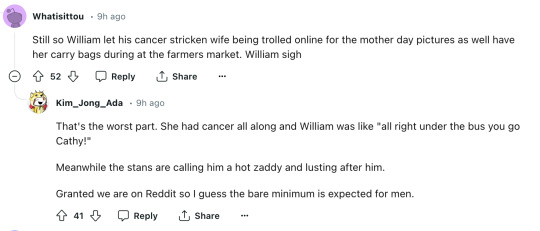
Still so William let his cancer stricken wife being trolled online for the mother day pictures as well have her carry bags during at the farmers market. William sigh
That's the worst part. She had cancer all along and William was like "all right under the bus you go Cathy!"
Meanwhile the stans are calling him a hot zaddy and lusting after him.
Granted we are on Reddit so I guess the bare minimum is expected for men.
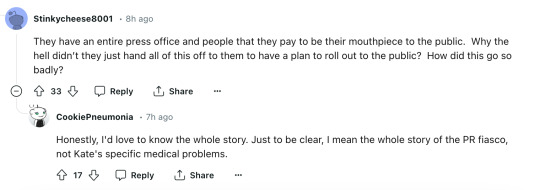
They have an entire press office and people that they pay to be their mouthpiece to the public. Why the hell didn’t they just hand all of this off to them to have a plan to roll out to the public? How did this go so badly?
Honestly, I'd love to know the whole story. Just to be clear, I mean the whole story of the PR fiasco, not Kate's specific medical problems.
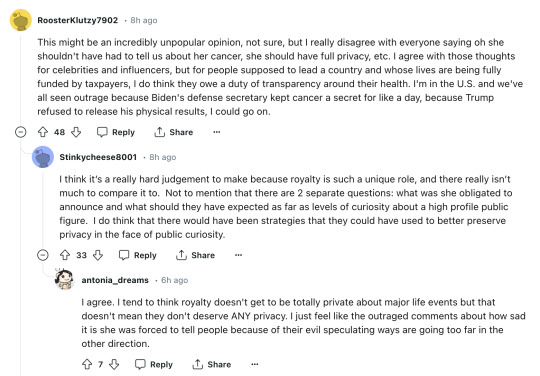
This might be an incredibly unpopular opinion, not sure, but I really disagree with everyone saying oh she shouldn't have had to tell us about her cancer, she should have full privacy, etc. I agree with those thoughts for celebrities and influencers, but for people supposed to lead a country and whose lives are being fully funded by taxpayers, I do think they owe a duty of transparency around their health. I'm in the U.S. and we've all seen outrage because Biden's defense secretary kept cancer a secret for like a day, because Trump refused to release his physical results, I could go on.
I think it’s a really hard judgement to make because royalty is such a unique role, and there really isn’t much to compare it to. Not to mention that there are 2 separate questions: what was she obligated to announce and what should they have expected as far as levels of curiosity about a high profile public figure. I do think that there would have been strategies that they could have used to better preserve privacy in the face of public curiosity.
I agree. I tend to think royalty doesn't get to be totally private about major life events but that doesn't mean they don't deserve ANY privacy. I just feel like the outraged comments about how sad it is she was forced to tell people because of their evil speculating ways are going too far in the other direction.

I don't think she necessarily has to share a diagnosis, but expecting that she could disappear entirely from public view and no-one would ask any questions is ridiculous. They had at least two months to come up with any plan besides complete silence.

I never wanted them to discuss her medical issues but transparency would have helped. Don't treat people like idiots. They mishandled this, and there were a million ways to keep things private but not have things turn into a cluster. Prayers for Catherine.
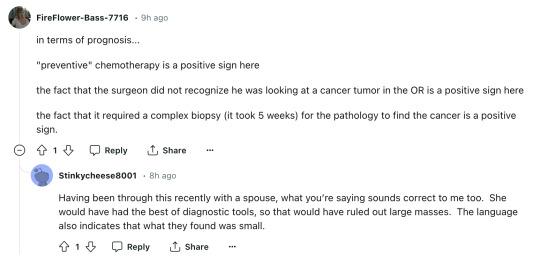
in terms of prognosis...
"preventive" chemotherapy is a positive sign here
the fact that the surgeon did not recognize he was looking at a cancer tumor in the OR is a positive sign here
the fact that it required a complex biopsy (it took 5 weeks) for the pathology to find the cancer is a positive sign.
Having been through this recently with a spouse, what you’re saying sounds correct to me too. She would have had the best of diagnostic tools, so that would have ruled out large masses. The language also indicates that what they found was small.

whoever ran the PR definitely did it poorly. Part of the reason the mother's day photo blew into a bigger news event was all the major news agencies put out a kill notice on it. and they only did that because Kensington palace declined to share the unedited one when asked.
Chetwynd said news agencies asked Kensington Palace to provide the original photo, but they did not receive a reply. That’s when they decided to issue “kill notices,” something that is very rarely done.
but they didn’t stick to the timeline.. they decided to reveal a doctored image and then make Kate take the fall for it. even if she did edit the picture on her own just for fun, they didn’t have to put it on her alone? the whole thing was so odd.
They could have skipped the fake photo release. They could have reacted to the swell of interest by putting out a statement that there have been developments and they will communicate when they are ready. To pretend nothing happened since the Jan announcement is disingenuous and PR is about real time handling
#my gif#reddit#british royal family#PR fail#kate middleton#Catherine The Princess of Wales#kensington palace#palace officials#MESS!#William The Prince of OWN GOALS#William The Weak#William The Terrible#William The Prince of Wales#prince william
22 notes
·
View notes
Text
OC Introduction Post!!!
Dr. Francesca Scott
Head of Oncology at PPTH (after Wilson leaves in S8)
Birthday February 15, 1976, 36 years old
Cisgender, currently questioning her sexuality, she/they
6 foot, 4 inches tall
Hazel eyes
Mid-shoulder length, thick, curly black hair
Vascular birthmark on the right side of her body, has a few patches on their face, neck, torso, arms, and legs, with the majority of the birthmark concentrated on her hands and feet
Jewish
Distantly related to Cuddy, Francesca's mother is Cuddy's cousin
Backstory
Francesca is an only child. She grew up with a lot of pressure put on her by her parents to succeed academically. Because of this pressure put on her her entire childhood, Francesca feels that if she is not succeeding at everything in life, she is failing the people that she loves.
Francesca was diagnosed with a brain tumor at six. The tumor was at an inoperable size, so she underwent chemo to try and shrink the tumor. After her chemo plan ended, the tumor was still at an inoperable size. The doctors estimated that she only had a year left to live. One of her doctors convinced her parents to try chemo for just a bit longer, and after this it was discovered that the tumor had miraculously shrunk to an operable size. The doctors were able to remove the tumor, and after more chemo and radiation therapy, she was declared cancer-free. Francesca has now been in remission for 30 years. It was because of this experience that Francesca decided to become a pediatric oncologist.
They have officially been nicknamed "Wilson" at the hospital because they share many of Wilson's little mannerisms, and because they have also been married three times. Her first husband was abusive, and she divorced him after he hit her for the first time. Her second husband was the love of her life, but he died in the same car crash where Haven (he's my other OC who she's in a QPR with) lost his leg. Her third husband didn't want kids, and Francesca divorced him when she discovered that he had been cheating on him.
She was diagnosed with depression after her second husband died and Haven lost her leg in the car crash. They had depression before this point, but the crash pushed it past the point where she was normally able to deal with it. However, she often forgets to take her antidepressants due to the chaotic nature of her job.
Francesca wants to be a mother more than anything. However, she has had a variety of problems with trying to adopt and foster, and she is unable to conceive herself due to infertility caused by her chemo as a child.
Worked as the Head of Pediatric Oncology at another hospital for about three years before coming to work at PPTH.
Profile picture!


12 notes
·
View notes
Text
In the summer of 2023, Gleb Aleksandrov, a self-proclaimed doctor from Russia with a history of charging patients for ineffective “treatments” such as singing folk songs to them, set up shop in Bishkek, Kyrgyzstan. But according to an investigation from the Kyrgyzstani news outlet Kloop, Aleksandrov’s clients are far from the only people his new venture could endanger: he also claims to be producing drones for the Russian military in a facility that shares an address with his health center. Meduza shares an English-language adaptation of the story.
The Dmitry Rayevsky Psychology and Health Center in Bishkek, Kyrgyzstan, has a rating of 4.3 out of five stars on the digital map service 2GIS. Most of the comments are good; one user says the center helped him overcome depression, for example, while another says it helped her get through a tough divorce.
But when the comments are bad, they’re really bad. “One person had a tumor, and his parents refused chemotherapy. Psychologists at this clinic worked with them, and the tumor actually grew. Another mother lost her child,” reads one. Another simply says: “My aunt died because of you.”
For anyone familiar with the past work of the health center’s founder, these reviews are unsurprising. “Dmitry Rayevsky,” whose real name is Gleb Aleksandrov, began his career in Russia, where he referred to himself as a “doctor-innovator,” a “political scientist,” a “patriot,” and an “oncology psychologist,” all while claiming noble ancestry. Charging up to 1.5 million rubles ($16,400) for his services, he “treated” autism and cancer with methods such as singing folk songs and placing his hands on people. And when his patients occasionally died in agony, he blamed their “evil auras.” According to the Russian newspaper Izvestia, Aleksandrov ran a “cult” in the Moscow region, “brainwashing” his followers into selling their own apartments and giving him the money.
Aleksandrov’s schemes were widely covered in the Russian press, with at least six TV segments devoted to them and multiple news stories published online. One woman from Yekaterinburg gave a detailed account of how the quack doctor had “sent her son to the next world.”
The reporting eventually led state investigators to get involved, and in early 2023, Aleksandrov’s “miracle clinic” in Moscow was shut down. In the fall, the authorities opened two felony cases against him. But by then, Aleksandrov was one step ahead: he had already opened a network of “clinics” in Kazakhstan, and he had big plans in Kyrgyzstan — ones that went beyond the medical field. In July 2023, he registered a business called the Valkyrie Construction Bureau at the same address as his Psychology and Health Center.
The doctor diversifies
In June 2023, a job vacancy for an electronics engineer appeared on the classified ad website Headhunter.kg. According to the listing, the new employee would be tasked with “organizing drone production in Bishkek.” The ad was posted by someone named Yevgeny Anatolyevich Boldyrev, whose profile on the site includes a link to the website Judging from financial records, both companies appear to have been just as hollow as his promises of curing cancer. This domain name belongs to a Moscow-based LLC called Valkyrie Construction Bureau, which, according to the site, manufactures “aircraft, including space vehicles, and related equipment.” The site also lists military drones available for purchase.
The Valkyrie Construction Bureau’s social media pages say the company makes combat drones for the Russian Armed Forces. Dmitry Rayevsky (that is, Gleb Aleksandrov) is listed as a co-founder, while Yevgeny Boldyrev is named as the head of the operation. Boldyrev’s email address, [email protected], suggests he has close ties to the phony doctor. Elsewhere on the Internet, he refers to himself as a “student” of “Rayevsky.”
It’s clear from open sources that the Valkyrie Construction Bureau registered in Bishkek is linked to the company registered under the same name in Moscow. This means that the drones Gleb Aleksandrov plans to build in Kyrgyzstan will likely be used to kill people in Ukraine.
“Unmanned aerial vehicles are widely used in tactical military operations for things like artillery targeting, reconnaissance, observation, and monitoring,” Rayevsky said in a 2022 interview about Valkyrie in the Russian news site Novye Izvestia.
“We’re making drones for close-range reconnaissance up to five kilometers that are invisible to the enemy’s radar and resistant to various weather conditions,” said Valkyrie’s chief engineer, Alexander Kozlachkov, in a 2022 article about the company. “We’re also working on cargo drones capable of carrying up to 10 kilograms and staying in the air for up to two hours. They’ll be able to traverse quite long distances to break through enemy bunkers.”
Of course, there’s also a chance the Valkyrie Construction Bureau’s drones will prove to be just as much of a sham as his cancer treatment methods. But that doesn’t mean the operation will be any less harmful to Kyrgyzstan.
An uncanny resemblance
After reviewing the drone models for sale on the Valkyrie website, journalists from Kloop concluded that the company is likely not producing drones at all, but instead purchasing and reselling foreign devices under the guise of manufacturing them.
Valkyrie’s V-Coptr Falcon, for example, looks extremely similar to one made by the U.S. company Zero Zero Robotics, which has offices in China and Taiwan.
The EVO II Dual 640T V3 offered by Valkyrie resembles one made by the Chinese company Autel Robotics, which has branches in the U.S., Germany, Italy, and Singapore.
The photo provided by Valkyrie of one of the reconnaissance drones it offers is actually a screenshot from a video of a radio-controlled aircraft made by the Chinese company Skywalker Technology Co., Ltd., though the product details listed on the Valkyrie site differ from those of the pictured device.
An employee at the Dmitry Rayevsky Psychology and Health Center told Kloop that the business’s workers came to Bishkek from Russia but that “Dmitry Rayevsky” himself rarely travels to Kyrgyzstan. The employee did not know anything about the drones that are supposedly being manufactured at the health center’s address.
A lifetime of lies
It’s no coincidence that Gleb Aleksandrov chose Kyrgyzstan for his purported drone company. According to websites run by his past victims, Aleksandrov was born in Frunze (the Soviet-era name for Bishkek). His family soon moved to the Russian city of Smolensk, where he first claimed to be descended from nobility and began using the pseudonym Rayevsky.
On Telegram, where he has nearly 100,000 followers, Aleksandrov is a vocal supporter of the war against Ukraine. His enthusiasm for Russia’s military aggression appears to date back at least to the annexation of Crimea, during which he founded an LLC called Development of Crimea and Sevastopol Industrial Construction Holding and another called Crimea Industrial Consortium Trading House. Judging from financial records, both companies appear to have been just as hollow as his promises of curing cancer.
But whether Aleksandrov is lying about Valkyrie manufacturing its own drones or not, the company could still have consequences for Kyrgyzstan: the E.U.’s 12th package of sanctions will reportedly carry tough penalties for third-country companies helping Russia circumvent them.
In August 2023, U.S. Senator Bob Menendez asked Kyrgyzstani President Sadyr Japarov to better regulate the flow of goods to Russia to prevent defense-related items, including drones, from entering the country. In response, Japarov said that the export of drones is against the law in Kyrgyzstan. The outlet Economist.kg, however, was unable to get an official response from the Economic Ministry about whether such a ban is really in place.
12 notes
·
View notes
Note
I’ve been so ill this past few weeks and been hospitalized because of medical concerns. Found out that I have a tumor and it was already malignant. I have a Stage 2A Cervical Cancer and needs help ASAP. 🥺
GOAL: $1800
ok that's nice and all but like.
1. why send this in an ask to a very not popular blog
2. no cashapp link or reference to check your profile. or anything. what
7 notes
·
View notes
Text
Breast Cancer
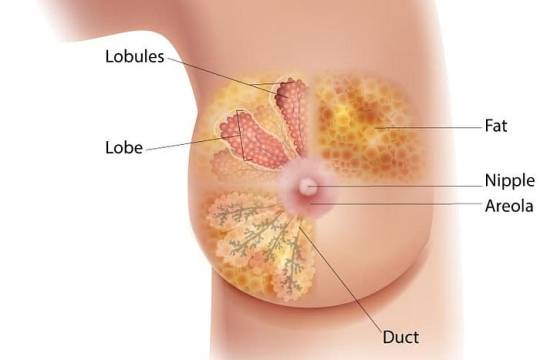
Introduction
Breast cancer, a multifaceted and prevalent disease, poses a significant health challenge globally, transcending gender lines with its potential impact. Characterized by the abnormal proliferation of cells within breast tissue, breast cancer’s complex etiology remains an area of intense study and concern. Despite notable advancements in medical science and increased awareness, it continues to be a leading cause of morbidity and mortality worldwide. This comprehensive discussion aims to delve into the intricacies of breast cancer, encompassing its causes, risk factors, prevention strategies, diagnostic modalities, treatment options, and the evolving landscape of supportive care.
Causes and Risk Factors
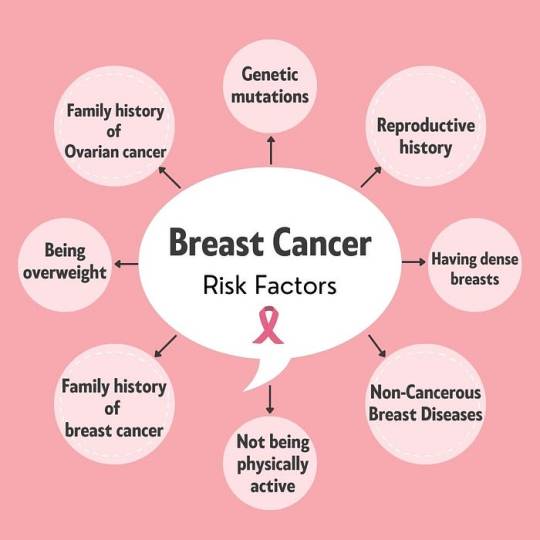
Understanding the underlying causes and risk factors associated with breast cancer is paramount in developing effective prevention and management strategies. While the precise etiology of breast cancer remains elusive, various genetic, hormonal, environmental, and lifestyle factors contribute to its onset and progression. Genetic predispositions, such as��mutations in the BRCA1 and BRCA2 genes, significantly elevate the risk of developing breast cancer. Additionally, hormonal influences, including early onset of menstruation, late menopause, and hormone replacement therapy, play a crucial role in disease pathogenesis. Lifestyle factors such as excessive alcohol consumption, obesity, lack of physical activity, and exposure to environmental carcinogens further augment the risk profile.
Preventive Measures
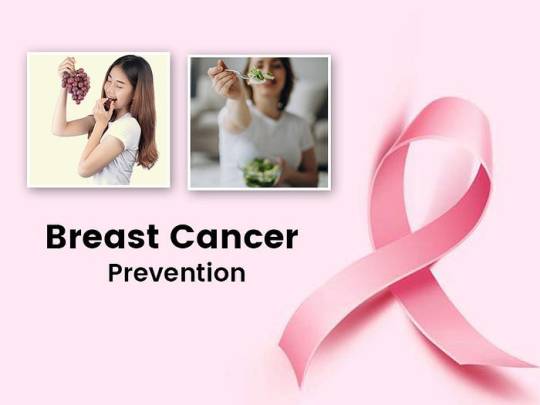
Empowering individuals with knowledge about preventive measures is essential in mitigating the burden of breast cancer. Promoting regular breast self-examinations, clinical breast examinations, and mammographic screenings facilitates early detection and intervention. Emphasizing lifestyle modifications, including maintaining a healthy weight, adopting a balanced diet rich in fruits and vegetables, limiting alcohol intake, and engaging in regular physical activity, can reduce the risk of breast cancer. For individuals with a heightened risk due to genetic predispositions or familial history, prophylactic surgeries, such as mastectomy or oophorectomy, and chemo preventive agents offer viable preventive options.
Diagnostic Modalities
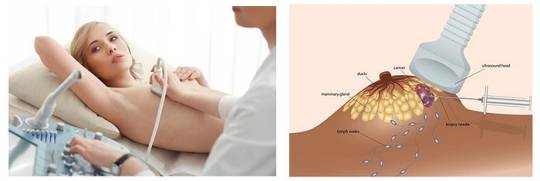
Advances in diagnostic modalities have revolutionized the early detection and diagnosis of breast cancer, enabling prompt initiation of treatment and improved clinical outcomes. Mammography remains the cornerstone of breast cancer screening, capable of detecting abnormalities such as microcalcifications, masses, or architectural distortions. Complementary imaging techniques, including ultrasound, magnetic resonance imaging (MRI), and molecular breast imaging (MBI), enhance diagnostic accuracy, particularly in women with dense breast tissue or high-risk profiles. Biopsy procedures, such as core needle biopsy or surgical excision, facilitate histopathological examination, enabling precise diagnosis and classification of breast lesions.
Treatment Options

Tailoring treatment strategies to individual patient characteristics and disease parameters is essential in optimizing therapeutic outcomes in breast cancer. The treatment landscape encompasses a multidisciplinary approach, integrating surgical, medical, and radiation oncology interventions. Surgical options range from breast-conserving surgeries, such as lumpectomy or segmental mastectomy, to radical procedures like total mastectomy or modified radical mastectomy, depending on tumor size, location, and extent of spread. Adjuvant therapies, including chemotherapy, hormonal therapy, targeted therapy, and immunotherapy, aim to eradicate residual disease, prevent recurrence, and improve overall survival. Radiation therapy, administered either postoperatively or as a primary modality in selected cases, targets residual tumor cells, minimizing locoregional recurrence rates.
Supportive Care and Survivorship

Recognizing the holistic needs of breast cancer patients and survivors is integral in promoting comprehensive care and ensuring optimal quality of life. Supportive care interventions, including symptom management, psychosocial support, nutritional counseling, and rehabilitation services, address the multifaceted challenges associated with cancer diagnosis and treatment. Survivorship programs, focusing on survivorship care planning, surveillance for recurrence, long-term monitoring of treatment-related complications, and health promotion initiatives, facilitate the transition from active treatment to survivorship. Engaging patients and caregivers in survivorship care planning fosters empowerment, resilience, and a sense of agency in navigating the post-treatment phase.
Conclusion
In conclusion, breast cancer represents a formidable health challenge with profound implications for affected individuals, families, and communities worldwide. While significant strides have been made in understanding its pathophysiology, enhancing diagnostic capabilities, and expanding treatment options, concerted efforts are warranted to address existing gaps in prevention, early detection, and access to care. By fostering collaborative partnerships among stakeholders, advocating for evidence-based interventions, and promoting health equity, we can strive towards a future where breast cancer incidence and mortality rates are substantially reduced. Through continued innovation, education, and advocacy, we can transform the landscape of breast cancer care, offering hope, support, and healing to those impacted by this pervasive disease.
We wish you all the best in your medical education journey. In case you need any guidance or assistance during the learning process, do not hesitate to reach out to us.
Email at;
#fullmetal alchemist#healthcare#medical students#assignment help#puppies#aesthetic#ratblr#kittens#pets#plants#nursing student#nurse#nursing school#home nursing services#doctor who#fourteenth doctor#14th doctor#tenth doctor#medicine#medication#pharmacy#big pharma#pharmacy colleges#pharmacy student#pharmacy services#pharmacy school#pharmacy technician#health and wellness
9 notes
·
View notes
Note
hi! would you like to tell us about your research?
thank you anon, this means a lot to me.
The lab I'm working in this summer studies a type of virus called reovirus. It's an RNA virus like HIV or Covid, but unlike those viruses reovirus doesn't cause disease in humans. This brings us to the first and second uses of reovirus in virology: it's a good first virus for undergrads like me because it isn't dangerous, and it's a way to study the basics of more dangerous viruses without putting people at risk. Reovirus is a common model for rotavirus, which also has a double-stranded RNA genome but does cause disease in humans (it's a common cause of diarrhea in kids).
The third reason we study reovirus is because of how it interacts with our immune system. Much of what we think of as being sick is actually our immune system trying to kill off a pathogen- inflammation, runny noses, and other fun reasons to skip work are all signs of the immune system functioning as intended. Reovirus triggers immune responses that don't cause physical symptoms, however.
Which leads us to cancer.
Fundamentally, cancer is a failure of the immune system. Cells and the organisms they are a part of have a lot of failsafes to stop cancer from happening, and tumors need to avoid getting caught in them. This typically looks like accumulating mutations to cause unrestricted growth and then suppressing the immune system to allow that growth to continue (more on this). This has led to the idea that we could treat cancer by reactivating the immune system when cancer shuts it off. There are a wide range of therapies in this vein that are currently being developed, with intentional infection with reovirus being one that's currently in human clinical trials. The idea, metaphorically, is to have reovirus move into a tumor and have a housewarming party so wild that the cops get called, even though this is a neighborhood that the cops usually turn a blind eye to.
What makes reovirus particularly promising is that it prefers to infect cancer cells over healthy cells! To quote the American Cancer Society on why this is important:
Cancer cells tend to form new cells more quickly than normal cells and this makes them a better target for chemotherapy drugs. However, chemo drugs can’t tell the difference between healthy cells and cancer cells. This means normal cells are damaged along with the cancer cells, and this causes side effects. Each time chemo is given, it means trying to find a balance between killing the cancer cells (in order to cure or control the disease) and sparing the normal cells (to lessen side effects).
This means that one of the main issues of treatments like chemo, that they target quick-dividing cells rather than tumor cells only, could possibly be a nonissue with reovirus treatment.
What my labmates and I are looking at this summer (besides getting the lab back up and running, but that's a whole different story) is how reovirus specifically pulls in a part of the immune system called the interferon response, which is basically an SOS signal that causes cells to turn a bunch of genes on or off. We're also looking at whether cells with different metabolism profiles react to infection differently, and whether this can be used to specifically target certain cancers. My lab is just getting started right now (see: above parenthetical), but the work that's already been done is so exciting and I love talking about it!
Here's a chapter on reovirus from an ancient textbook, and here's a review of work on interferons, if you want to know more!
3 notes
·
View notes
Text
#cbd#glioblastoma#cannabis#marijuana#weed#pot#legalization#medical marijuana#mmj#medical cannabis#legalize#nih#national institutes of health
2 notes
·
View notes
Text
youtube
#Tislelizumab#advanced gastric cancer#first-line treatment#immunotherapy#anti-PD-1#monoclonal antibody#cancer treatment#progression-free survival#overall survival#oncology research#chemotherapy#tumor response#survival rate#gastric cancer care#clinical trials#safety profile#patient outcomes#immune checkpoint inhibitor#combination therapy#cancer immunotherapy.#Youtube
0 notes
Text

These past few years, I have become a huge advocate for feeding fresh food to dogs to enhance their lives. However, you don't exactly have to transition your dog to a 100% fresh food diet in order to gain the benefits of fresh food.
Simply adding fresh food to your dog's kibble can go a long way in improving their nutrition and overall health. For instance, one study done a group of dogs in 2005 revealed that feeding vegetables just three times a week had significantly lowered their risk of developing cancer, compared to dogs who were only fed kibble.
Asian markets, in particular, have some very beneficial fresh food items that aren't typically found at your local grocery store. These food items, however, are not intended to fully replace your dog's food. Remember - too much of something good can be bad for you.
Instead, they should be offered in moderation as treats, or just small amounts topped over an already complete and balance meal. As a general rule of thumb, treats/toppers should never make more than 10% of your dog's overall diet.

Bok choy (Chinese cabbage) is full of essential vitamins and minerals needed to support a dog’s eyesight, cardiac function, digestion, bone strength, and immunity. Sulfurophane - a compound found in bok choy and other cruciferous vegetables - has been linked to inhibiting cancer cell growth, lowering blood pressure, and activating the nuclear factor Nrf2 which prevents the development of diabetes and its complications. Bok choy’s low calorie, high fiber content also make it a good option for a snack/food topper for dogs who need to control their weight.
Preparation: Lightly steam or boil for better nutrient absorption. Cooking will also help neutralize the enzyme (myrosinase) that can decrease thyroid function. You should also chop/trim their long leaves to avoid choking hazards.

Goji berries (wolfberries) are rich in amino acids, carotenoids which support healthy vision, and polyphenols that have anti-inflammatory, anti-tumor, and cardio-protective properties. Studies on goji berry supplementation in animals have shown that it has the potential to help lower cholesterol, protect the liver by increasing hepatic antioxidant activity, as well as enhance metabolic homeostasis and prevent diabetes-induced renal inflammation.
Preparation: Remove stems if still attached and cut/mash berries. If dried, soak in water until softened to avoid passing straight through the GI tract and losing the benefits of its nutrients.
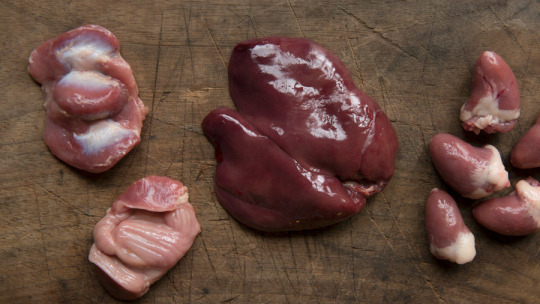
Offal refers to the internal organs and variety meats of animals that can be consumed as food (i.e. lung, heart, kidney, liver, gizzard, head, feet, etc.) The word 'offal' literally translates to "fall off", and thus, whatever falls off the skeleton during the butchering process. Offal is densely loaded with essential vitamins, minerals, proteins, and fats - so small amounts go a long way. Pet owners who use these as ingredients as part of a complete and balanced recipe should keep in mind that each organ is unique in its nutrient profile - dependent on the animal it is sourced from and how it is raised. For example, grass-fed beef may contain less fat yet more vitamin A and E than grain-fed beef, and beef liver has significantly more vitamin A and copper than chicken liver.
Preparation: Boil in water or low-sodium broth. May also be baked or dehydrated into jerky treats.
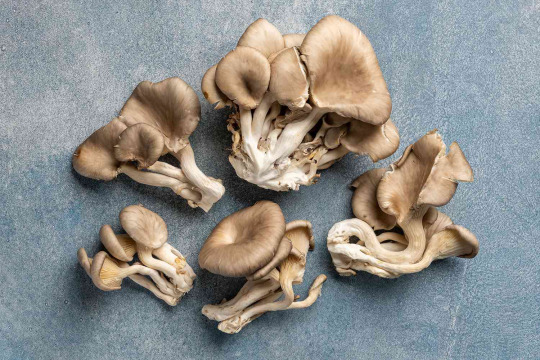
Oyster mushrooms are a good source of protein and fiber, and vitamins that support healthy digestion. They can help to increase satiety and maintain healthy body weight. Oyster mushrooms are also full of pantothenic acid which help to maintain cognitive function and healthy skin/coat. Beta-glucans derived from oyster mushrooms have also been shown to reduce inflammation and strengthen immunity.
Preparation: Lightly sauté or boil in water or low-sodium broth. Raw or dried mushrooms can be difficult for dogs to digest.

Purple sweet potato (Ube or Okinawan sweet potato) are typically found in grocery stores more commonly during the fall/winter seasons. They contain more antioxidants than regular sweet potatoes due to the anthocyanins that cause their violet hue. While all potato varieties may impact blood sugar levels because of their high carbohydrate content, purple potatoes may exert less of an effect because of their high polyphenol content that decreases the absorption of starches in the intestines. In addition, they have been linked to improving blood pressure, likely due to their high potassium content.
Preparation: Peel skin and bake until soft for better digestibility and to prevent intestinal blockages. May be boiled and drained to reduce oxalate intake for dogs with a history of bladder stones, or prone to urinary issues.

Quail eggs are small, yet packed with protein and essential fatty acids, and have a higher ratio of iron, riboflavin, and vitamin b12 than chicken eggs. It is even safe and can be beneficial to feed them with the shells included for added calcium. Quail eggs have been linked to improving bone growth/healing, reducing liver damage, and increasing energy levels. While some studies have shown evidence of quail eggs treating allergies in humans and mice, they may be less likely to trigger reactions than chicken eggs in dogs who have poultry sensitivities.
Preparation: Wash thoroughly, and handle gently as they are more fragile due to their tiny size. Cooking methods are similar to that of chicken eggs, yet require less time.
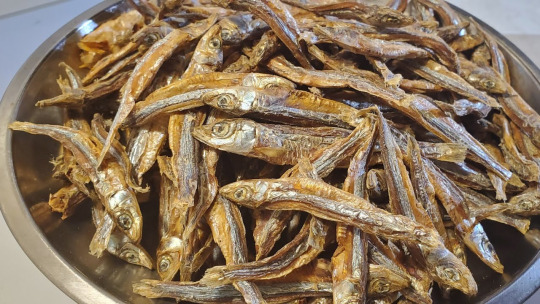
Sardines contain all the amino acids your dog needs for optimal health, making it a "complete protein". They are also notorious for being rich in omegas and coenzyme q-10, which help support heart and brain health. What sets sardines apart from other fish, too, is that they are smaller and more short-lived species than larger predator fish and may have less of a risk for mercury poisoning. Because they are so small and have soft bones, you can feed them whole to your pets.
Preparation: Bake or dehydrate. If already purchased as dried, be sure to make sure there is no added salt or seasonings. If canned, preferably those stored in water only.

Sushi rice (Japanese sticky rice) has a high proportion of starch and moisture, giving it a stickier texture when cooked. Sushi rice has virtually zero fat, yet still provides a desirable balance of nutrients while remaining gentle on a dog’s digestive tract. Its higher iron content than regular rice supports healthy blood circulation and can provide more energy to dogs who are recovering from illness. Cooling/refrigerating the rice before serving also enables more retrogradation of prebiotic fiber, helping to lower glycemic responses and maximize intestinal function.
Preparation: Rinse thoroughly and soak in water (with 1tbsp apple cider vinegar - optional) before cooking. If you don’t have a rice cooker or instant pot, boil on the stove until the water is completely absorbed. May be cooked with bone broth for added flavor. You can also use small amounts of beet root powder, turmeric, or blue spirulina to add color and nutrients.
#asian markets#pet food#dog treats#bok choy#goji berries#offal#oyster mushrooms#quail eggs#sardines#sushi rice#purple sweet potato
8 notes
·
View notes